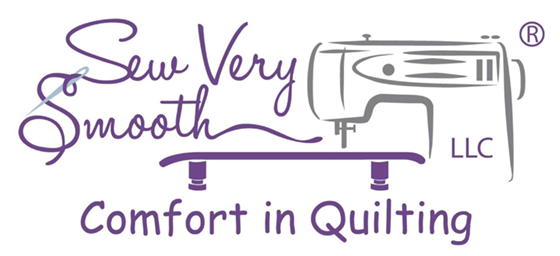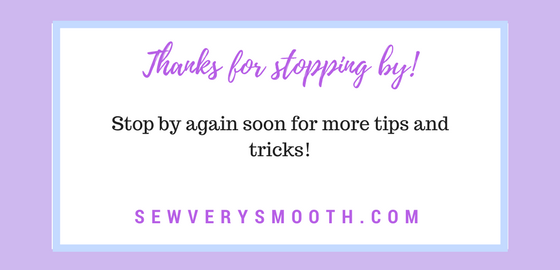Sew Very Smooth Blog
A Second Mini Quilt
by Steve Tippets on 11/03/17I've spent a lot of time looking over my finished mini quilt. I needed to figure out how to fix the mistakes I made. My main focus is the misalignment of the rows. My lines are straight, but it doesn't matter if they don't fit together correctly.
After looking back over all of my steps I think I have it narrowed down to two issues. The first was that I accidentally switched between a 1/4" seam and a scant 1/4" seam. I was using my Ideal Seam Gauge to set the seam and I was halfway through before I realized I hadn't been being consistent. By then it was too late to fix but I was hoping it wouldn't make that much of a difference. I was wrong.
The second issue was that when I did the half square triangles and I trimmed them up I didn't take the time to measure them and make sure they were all the same size. It was a big oversight on my part, but I'm hoping I can do better on my next project.
And speaking of my next project. I decided to try another mini quilt. I was tempted to get the same pattern again to see if I could correct my mistakes, but I decided to go with a different pattern that also uses the half square triangle. That way I end up with a new project but I will know that I've gotten better with the triangle when it's all said and done. Plus, I love the color scheme of this new one.

Cutting out the pieces was easier this time around. I'll be using a few larger squares this time so I didn't have to cut as many, but I did have to do more strips which are harder to keep consistent.

With the first quilt I didn't realize I could use the Ideal Seam Guide with the half square triangle but it turns out you can! You just have to put the guide on top of the fabric the same way I did when I used it for the quilting stitches on my last project.

The finished product had lines and perfect 1/4" seams, which is a great step in having my rows line up correctly this time.
Once I cut my squares and pressed the seams it was time to square them up.
I feel kind of silly that last time I didn't utilize the angled guide on my self healing mat. I didn't realize it was there until I had all but three squares trimmed. This time I made sure to use it and measured to make sure each square made the required 2 1/2" x 2 1/2" measurements.

They already look so much better than they did last time around. I am really excited to start sewing them all together to show how well they fit together.

Does anyone have any other suggestions on how to do better? I know you only get to see the pictures which aren't the same thing, but I would sure appreciate knowing if you had any thoughts when viewing the pictures. Perhaps you thought something like, "She should have done this instead." Or maybe, "I wouldn't have done that." It's helpful to have any guidance you can give. I'll take feedback on any part of the process, not just these half square triangles.
My First Project is Finished!
by Steve Tippets on 10/27/17What a crazy week. I've been so excited to finish this little quilt up so that I can figure out where I need to improve and what I need to practice.
I finished up the quilting stitches without any problems. My favorite part was trimming the extra batting and the bottom sheet. It just looked so much closer to being done!

I was finally on the last step, the binding. I will admit I've been really nervous about this since I read through the instructions. I did not understand what they were telling me to do. Thankfully my Mom was here for a visit this last weekend and was able to explain to me what it was saying.
Creating the binding strip was easy enough. I had three lengths of fabric that I needed to combine into one long strip.

Yes, I took a picture of one of the seams. I did not, however, take a picture after I pressed it folded in half. I thought that might be a little overkill.
It was then time to attach the binding to the quilt. This ended up being so much easier than I expected it to be. Especially since I used my Ideal Seam Guide again so I could get the perfect 1/4" seam. I did have to fight gravity a bit to keep the quilt lined up with the binding. I have a portable extension table coming, but it's taking a little longer than normal because I have a new model sewing machine so they don't have the dimensions set for it yet. I'm really looking forward to having my table though.

The corners were a little tricky, but I took my time and made sure they were lined up properly before I continued. It was worth the extra time to have it lay properly.

The flip of the binding went extremely smoothly because everything was lined up correctly.
I know it's possible to sew the back with a machine, but I decided to hand stitch it. I just know that if I had used the machine the seam would be showing or I'd miss a portion of the binding so it wouldn't be secure. That would drive me nuts.
It actually didn't take that long to sew by hand. My almost two year old son kept trying to take it off of my lap as I sewed. I think he liked the quilt and wanted to snuggle with it. I'm pretty pleased with how it turned out.


The back is my favorite part. I honestly don't have any frustrations with how the binding turned out. The only thing I'm wondering is if it is better to finish it with the machine. This small 17 1/2" x 17 1/2" quilt took just under two hours to hand stitch. I was careful to make sure the stitches couldn't be seen but I don't feel like I was sewing at a slow pace. I can't imagine how long it would take to hand stitch a twin sized quilt or something even larger.
Do you have any tips on binding? Will it always be a slow process or are there faster ways to get it done? Are there any sure ways to use the machine without showing a bunch of stitches?
I've really loved working on this quilt. I've always had a feeling I would enjoy sewing but I never wanted to invest in a hobby I wasn't sure I'd enjoy. And as you all know quilting in particular is not cheap. I'm so grateful I've taken this leap and started learning. It's been everything I'd hoped it would be. It's even helped me out in my roll as a mom.
This week is Red Ribbon week at my daughter's school. Each day this week has had a theme that the students are supposed to follow in how they dress. Today the theme is Super Heroes. The kids are allowed to wear capes and masks and any other super hero clothing they have. We had two capes that would fit my oldest and youngest daughters, but my poor middle daughter didn't have a cape to wear. I didn't think it was a big deal because she is the only one with an actual superhero shirt to wear, but I was wrong. She told me in near tears that she really wanted to wear a cape too.
I'll admit it, when it comes to my kids I'm a bit of a sucker. I looked at my sewing machine sitting on my desk and I thought, "I can make a cape." So I did.
I spent almost four hours last night figuring it out, but I did it. Thankfully I had enough material on hand to throw it together. I didn't take pictures along the way because I wasn't thinking about it as a blog entry, it was just something I was doing for my daughter, but I do want to show the final product because I'm pretty proud of it.


The heart patches are because I accidentally cut holes in the material as I was cutting out the cape, but I think they're cute. It is also lined with white to give it a little thickness. It's not perfect. There are so many mistakes that scream at me, but my daughter was tickled to wake up this morning to find she had her very own cape. It made it all worth it. Isn't she an adorable superhero?



The Quilting Stage Has Begun
by Steve Tippets on 10/20/17
The past few weeks I have tried to enjoy the journey, but I will admit I've spent a lot of time focusing on starting the steps this week. I've been simultaneously nervous and excited to have the top sheet fully assembled so I could begin the quilting phase.
The assembly went pretty smoothly, other than the fact that I could tell each row didn't line up perfectly.

My first attempt at assembling these two rows together did not go well. I didn't line the green square in the middle very well and it drove me nuts so I had to take the time to rip the seam and go again. I didn't get a picture of it all crooked, but trust me, it looked awful.
Once they were completely assembled I had to baste. I will admit that when I read the word baste in the instructions and I had no idea what it meant. I had to spend some time on Google to figure out it just meant layering the bottom, batting, and top sheet together. There are two main methods people use, but I didn't know that going in so I didn't have the spray all ready to go. Naturally, I went the pin route, but I used T pins because I don't have the basting pins. I may have to get some because it is no fun to get poked while handling the quilt.
I definitely need some guidance here. Do any of you have any strong opinions on basting?

I tried to keep the pins two and a half to three inches apart. The batting I used was just what I had on hand from a non-quilt related project I did last year and it said to quilt within five inches. I figured it is better to over pin than not have enough pins.
Please let me know if you think I should do something differently next time.
Once that was done it was time to start quilting. I'm struggling with this a bit. Mainly because I wasn't sure of the best route to go. The instructions said to 'stitch in the ditch' but the lines weren't straight so if I followed the ditch the line would zig zag all over the place. It would be hidden, but the back would look weird. I also knew that if I kept the line straight that it wouldn't follow the ditch at all and could possibly make the front look weird, which would ruin all the work I've put in.
Ultimately I decided to go with a straight line. I'm halfway done and I'm not sure how I feel about how it's turning out.
On the bright side, the lines are straight. I used my Ideal Seam Guide to stitch. It made keeping a straight line so much easier. In order to make it work I had to put the guide on the fabric itself and not the machine, but I love that it's possible to do that.

Using the guide makes the process take a little longer, but I think it's worth the time to use it.

I didn't want to post the picture of my quilting job. I like having the straight lines, but I hate that some of those lines don't go through the corners. The overall effect is pleasing to the eye, but if you look too closely it's a little cringeworthy.
There is one line that didn't end up very straight. My guide had gotten pretty linty and needed to be cleaned but I didn't realize how linty it was until I was committed. I had to stop using the guide and eyeball it. It didn't go well.

It is a nice visual to show just how helpful the guide was for me. The back is the best indicator on how straight the lines are. There is an optical illusion of wavy lines because of the blue pattern, but they are straight.

The back is also the part that makes me glad I chose to go straight rather than sewing in the ditch. I'm still not sure I made the right decision, but the back is satisfying to look at.
I just hope I am happy with the finished product once I'm done. That is the goal.



